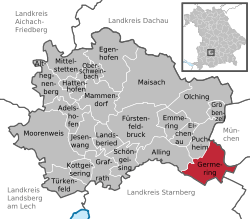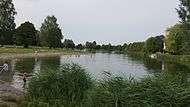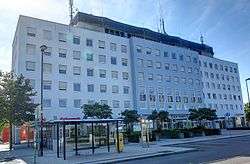Germering
| Germering | ||
|---|---|---|
|
Town hall | ||
| ||
 Germering | ||
Location of Germering within Fürstenfeldbruck district  | ||
| Coordinates: 48°08′N 11°22′E / 48.133°N 11.367°ECoordinates: 48°08′N 11°22′E / 48.133°N 11.367°E | ||
| Country | Germany | |
| State | Bavaria | |
| Admin. region | Oberbayern | |
| District | Fürstenfeldbruck | |
| Government | ||
| • Lord Mayor | Andreas Haas (CSU) | |
| Area | ||
| • Total | 21.61 km2 (8.34 sq mi) | |
| Elevation | 535 m (1,755 ft) | |
| Population (2015-12-31)[1] | ||
| • Total | 39,387 | |
| • Density | 1,800/km2 (4,700/sq mi) | |
| Time zone | CET/CEST (UTC+1/+2) | |
| Postal codes | 82101–82110 | |
| Dialling codes | 089 | |
| Vehicle registration | FFB | |
| Website | www.germering.de | |
Germering is a large town of approx. 38,000 within the district of Fürstenfeldbruck, in Bavaria, Germany. It is directly adjacent to the city of Munich and borders it to the west.
History
The area of Germering has an old history attested by findings of burial mounds of the New Stone Age and the Bronze Age, as well as a "Villa rustica" (as in nearby Leutstetten) built by the Romans. There was a trade route through the city with numerous brick kilns. After their discovery a glass roof was erected over one (near the Nebelerstrasse) so one can still view it.
Germering was first reliably mentioned about 859-864 A.D. In those days it was still known as Kermeringon, but apparently it was formerly mentioned under the name Germana vel admonte. Unterpfaffenhofen, the south-west part of Germering, was first named in a charter dated 1190, but both villages remained small and rural until they experienced several significant growths in population during the 20th century.
During World War II, a subcamp of the Dachau concentration camp was located in the town.[2]
In 1978, the two independent towns Unterpfaffenhofen and Germering were merged to present-day Germering. The new city coat of arms was created in 1981 by Karl Haas, who incorporated the coats of arms of both the two former boroughs.
Local profiles
The Biedermeier era artist Carl Spitzweg was born in 1808 in the town-district Unterpfaffenhofen.
The popular German band Sportfreunde Stiller is from here.
Alpine skier Lena Dürr grew up in Germering.[3]

Honorary citizen
- Robert Huber (born 1937), residing in Germering, received the Nobel Prize for Chemistry in 1988 and was appointed honorary citizen in the same year.
- Claudia Hengst, (born 1969), well-known disabled sportswoman and multiple gold medal winners at the Paralympics, world and European champion, has been an honorary citizen since 2001.
Sons and daughters of the town
- Carl Spitzweg (1808-1885), romanticist painter
- Peter Brugger (born 1972), (singer and guitarist, member of the Sportfreunde Stiller
- Thomas Huber (born 1963), actor (including Lindenstrasse - Der große Bellheim)
Personalities who have worked on the ground
- Gus Backus (born 1937) singer, lived in Germering, in the meantime, he moved back to Germering.
- Erhard Wunderlich (1956-2012), handball player, Silver medal winners at the Summer olympics 1984, lived in Germering.
- Siegfried Lowitz (1914-1999), actor, lived in Germering.
- John Christopher Howland (1928-2013), singer, actor and entertainer lived in Germering (Harthaus).
- Heinz Braun (1938-1986), painter, lived in Germering.
References
- ↑ "Fortschreibung des Bevölkerungsstandes". Bayerisches Landesamt für Statistik und Datenverarbeitung (in German). June 2016.
- ↑ "Archived copy". Archived from the original on 2009-02-09. Retrieved 2008-11-01.
- ↑ Janz, Thomas (3 February 2012). "Dürr: "I'm Not Going To Stress Myself Out!"". Fischer Sports. Retrieved 28 December 2013.

